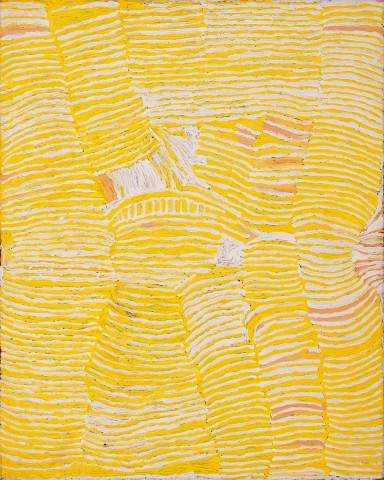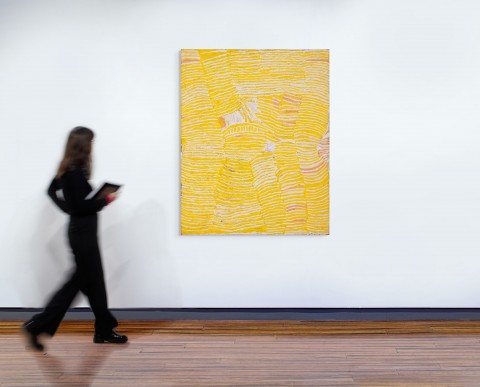PEEWEE, 2002
MAKINTI NAPANANGKA
synthetic polymer paint on Belgian linen
153.0 x 122.0 cm
bears inscription verso: artist’s name, size and Papunya Tula Artists cat. MN0208047
Papunya Tula Artists, Alice Springs, Northern Territory
Gallery Gabrielle Pizzi, Melbourne
Private collection, Victoria
Lawson~Menzies, Sydney, 14 November 2007, lot 56
Private collection, Melbourne
Lauraine Diggins Fine Art, Melbourne
Private collection, Sydney
Annual Collectors’ Exhibition, Lauraine Diggins Fine Art, Melbourne, 1 October – 8 November 2008
Senior Pintupi artist Makinti Napanangka was born at Mangarri, near Lake Macdonald, on the border of the Northern Territory and Western Australia. She was one of the original women who joined in the mid-1990s the artistic movement at Papunya Tula Arts, the crucible of contemporary Indigenous painting. Developing from the painting assistance many women already provided to their male relatives in Balgo, Warmun and Utopia in the mid-1980s, some art centres began to encourage works made independently by female artists, almost twenty years after the expressions of the Western Desert artists.1 The late flowering of female painting at Papunya was fostered by workshops and cultural exchanges between the women of the settlement at Walungurru (Kintore) and their kinswomen at Ikuntji Women’s Centre at Haasts Bluff.2 Here, Napanganka and her peers pioneered a new form of Western Desert painting characterised by free-form expressive brushwork, strong saturated colours and richly textured surfaces. Diverging from the men’s schematic and austere paintings of Dreaming Law, the women’s vital and radiant paintings express the jubilation of ceremonies at sacred sites on Country, a daring second wave of artistic revolution.
Vibrating with rhythmic free-hand striations of sunflower yellow and white, Peewee, 2002 is a mature, light-flooded work by Makinti Napanagka, painted after her vision had been restored following cataract surgery in 1999. This painting, like most in her oeuvre, refers to traditional life remembered and reestablished on country, and a sacred water source for which the artist has inherited custodianship in the temporal world. The Peewee (also known as the Magpie-lark, one of the Northern Territory’s native and protected species) is associated with an important Dreaming at the rockhole site of Lupulnga, south of the Kintore community. Lupulnga and the Peewee Tjukurrpa are one of Napangka’s principal stories, featuring often in her paintings alongside designs associated with the travels of the Kungka Kutjarra (Two Ancestral Women), who sang the land and visited the site on their way north to Kaakuratintja, Lake Macdonald. The recurring and all-over thickly painted rows of quivering lines and arcs commemorate the ceremonies at this site, particularly evoking the movement of nymparra, the hand-spun hair-string skirts worn by lead dancers, including Napanangka herself. The viscous impasto of Napanangka’s paint and its haptic texture replicate the generous application of ochre body paint in these women’s ceremonies.3
Makinti Napanangka was quickly established as one of the most senior women painting with Papunya Tula, which she officially joined as a shareholder and independent artist in 1996. In 2000, her innovative and energetic work was included in the major retrospective exhibition Papunya Tula: Genesis and Genius at the Art Gallery of New South Wales, Sydney, and in 2003, in the Clemenger Contemporary Art Award at the National Gallery of Victoria. In 2008, Napanangka won the National Aboriginal and Torres Strait Islander Art Award, her untitled painting of Lupulnga acclaimed by judge Judy Watson for its ‘inner light, and [it] outshines everything else.’4
1. McLean, I., Rattling Spears. A History of Australian Indigenous Art, Reaktion Books, Melbourne, 2016, pp. 152 – 56
2. Perkins, H., and Fink, H. (eds.), Papunya Tula. Genesis and Genuis, Art Gallery of New South Wales, Sydney, 2000, p. 197
3. Perkins, H., and West, M. (eds.), One Sun, One Moon: Aboriginal Art in Australia, Art Gallery of New South Wales, Sydney, 2007, p. 187
4. The Courier Mail, Brisbane, 17 August 2008
LUCIE REEVES-SMITH

